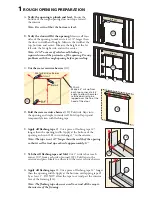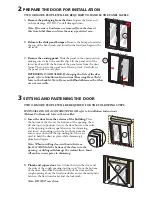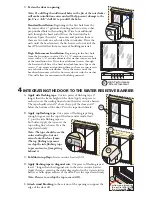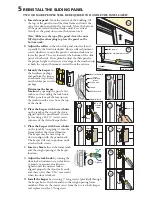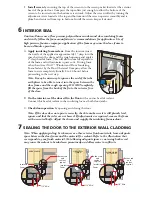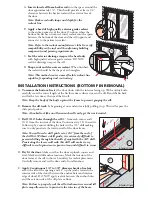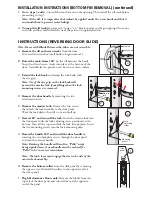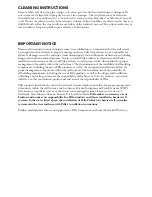
Note: When applying siding, brick veneer or other exterior finish materials, leave adequate
space between the door frame and the material for sealant. Refer to the illustration that
corresponds to your finish material. Not allowing adequate space or not using backer rod
may cause the sealant to break down prematurely and allow water to infiltrate.
7
SEALING THE DOOR TO THE EXTERIOR WALL CLADDING
A.
Apply insulating foam sealant.
From the interior, insert
the nozzle of the applicator approximately 1" deep into the
space between the door and the rough opening and apply a
1" deep bead of foam. This will allow room for expansion
of the foam and will minimize squeeze out. If using foam
other than Great Stuff
™
Window and Door Insulating
Foam Sealant by the Dow Chemical Company, allow the
foam to cure completely (usually 8 to 24 hours) before
proceeding to the next step.
Note: It may be necessary to squeeze the end of the tube
with pliers to be able to insert into the space between the
door frame and the rough opening. DO NOT completely
fill the space from the back of the fin to the interior face
of the door.
Caution: Ensure use of low pressure polyurethane window and door insulating foams
and strictly follow the foam manufacturer's recommendations for application. Use of
high pressure foams or improper application of the foam may cause the door frame to
bow and hinder operation.
6
INTERIOR SEAL
*OUFSJPS
È
B.
On the interior, seal the door sill to the floor
with a corner bead of sealant.
Connect this bead of sealant to the insulating foam at both door jambs.
C.
Check door operation
by opening and closing the door.
Note: If the door does not operate correctly, check to make sure it is still plumb, level,
square and that the sides are not bowed. If adjustments are required, remove the foam
with a serrated knife. Adjust the shims, and reapply the insulating foam sealant.
Insulating
Foam
BRICK VENEER
Backer rod
and
sealant
typical
1/2" Min.
1/2"
VINYL/STEEL
SIDING
Backer rod
and
sealant
typical
1/2" Min.
1/2"
WOOD SIDING
WITH TRIM
Backer rod
and
sealant
typical
1/2" Min.
1/2"
Insulating
Foam
Insulating
Foam
I.
Install screen
by inserting the top of the screen into the screen pocket located at the exterior
head of the patio door. Compress the top rollers just enough to allow the bottom of the
screen to be inserted onto the bottom screen track. Adjust the screen rollers by turning the
adjustment screw located at the top and bottom until the screen operates smoothly and is
plumb and centered from top to bottom. Install the screen keeper if desired.


